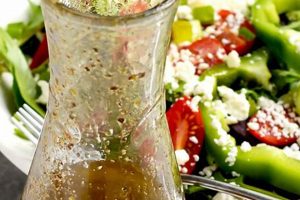A vibrant, tangy, and creamy dressing elevates the classic Greek salad. Typically, this involves emulsifying high-quality olive oil with lemon juice or red wine vinegar. The addition of crumbled feta cheese contributes a salty, savory dimension and a luxuriously creamy texture, distinguishing it from simpler vinaigrettes. Aromatic herbs like oregano and dill are frequently incorporated, along with seasonings such as salt, pepper, and sometimes garlic or Dijon mustard for added depth of flavor.
This style of dressing provides a substantial upgrade to the flavor profile of fresh vegetables, making them more palatable and adding a significant nutritional boost through the healthy fats from olive oil and the probiotics and calcium present in feta. Its Mediterranean origins speak to a long history of culinary appreciation for fresh, simple ingredients combined in harmonious ways. The resulting emulsion not only delivers flavor but also plays a vital role in coating and clinging to the salad components, ensuring each bite offers a complete sensory experience.
The following sections will explore variations on this essential condiment, offering insights into ingredient selection, preparation techniques, and creative applications beyond the traditional Greek salad.
Tips for Crafting an Exceptional Greek Salad Dressing with Feta
Elevating a Greek salad from simple to extraordinary hinges on the quality and execution of its dressing. Attention to detail in ingredient selection and preparation methods yields noticeable improvements in flavor and texture.
Tip 1: Prioritize High-Quality Olive Oil: The foundation of any great Greek salad dressing lies in the olive oil. Opt for extra virgin olive oil with a robust flavor profile that complements the other ingredients.
Tip 2: Freshly Squeezed Lemon Juice is Essential: Bottled lemon juice often contains additives that can detract from the dressing’s brightness. Freshly squeezed lemon juice offers superior flavor and acidity.
Tip 3: Balance Acidity and Salt: Achieve harmony by carefully balancing the tartness of the lemon juice or vinegar with the saltiness of the feta. Taste and adjust as needed.
Tip 4: Incorporate Authentic Greek Feta: Genuine Greek feta, made from sheep’s milk or a blend of sheep and goat milk, possesses a distinct flavor and texture that cannot be replicated.
Tip 5: Embrace Fresh Herbs: Dried herbs can be used in a pinch, but fresh oregano and dill provide a more vibrant and aromatic experience. Chop them finely to release their full flavor.
Tip 6: Emulsify Thoroughly: A proper emulsion prevents the dressing from separating and ensures the flavors are evenly distributed throughout the salad. Whisk vigorously or use a blender for a smoother consistency.
Tip 7: Consider Adding a Touch of Dijon: A small amount of Dijon mustard can add complexity and help emulsify the dressing, binding the oil and vinegar together more effectively.
Tip 8: Taste and Adjust Before Serving: Palates vary, so it’s always recommended to taste the dressing and adjust the seasonings to achieve the desired balance of flavors.
By following these tips, one can create a Greek salad dressing with feta that transforms ordinary ingredients into a culinary delight. The resulting dressing offers not only enhanced flavor but also a textural richness that elevates the entire salad experience.
These techniques and considerations provide a strong foundation for mastering the art of this classic Mediterranean dressing, opening up opportunities for culinary exploration and enjoyment.
1. High-quality olive oil
High-quality olive oil serves as the foundation of a superior Greek salad dressing with feta. Its selection significantly impacts the final flavor profile, texture, and overall quality of the dressing. Understanding the nuances of olive oil grades and flavor profiles allows for informed choices that elevate the sensory experience.
- Extra Virgin Olive Oil (EVOO):
EVOO, the highest grade of olive oil, results from the first cold-pressing of olives and boasts a low acidity level. Its rich flavor, ranging from peppery to fruity, depends on the olive varietal and terroir. Within a Greek salad dressing, EVOO provides a robust backdrop against which the other ingredients can shine. For instance, a Koroneiki EVOO with its peppery notes complements the saltiness of feta and the herbaceousness of oregano. Using EVOO ensures the dressing delivers both flavor and health benefits thanks to its high concentration of antioxidants.
- Flavor Profiles and Pairing:
Olive oil exhibits diverse flavor profiles, from delicate and buttery to robust and grassy. Selecting an oil that complements the other dressing components is crucial. A milder olive oil pairs well with a sharper feta, while a more robust oil can stand up to stronger flavors like garlic or red wine vinegar. Consider a Tuscan EVOO with its grassy notes when using milder feta, or a Spanish Picual EVOO with its peppery kick for a bolder dressing. The interplay of these flavors creates a more nuanced and enjoyable culinary experience.
- Impact on Texture and Emulsification:
High-quality olive oil contributes to the desired creamy texture of the dressing. Its viscosity helps create a stable emulsion with the acidic components, preventing separation and ensuring a cohesive mouthfeel. Lower quality oils may be thinner, resulting in a less stable emulsion and a watery dressing. The smooth, velvety texture achieved with good quality EVOO coats the salad ingredients evenly, enhancing flavor delivery.
- Health Benefits and Nutritional Value:
Beyond flavor and texture, EVOO offers significant health benefits. Rich in monounsaturated fats and antioxidants, it contributes to a heart-healthy diet. Including EVOO in the dressing adds nutritional value to the salad, making it a more wholesome and beneficial choice. This aligns with the Mediterranean diet principles, emphasizing fresh, natural ingredients and healthy fats.
The selection of high-quality olive oil is not merely a detail but a defining factor in the success of a Greek salad dressing with feta. It influences not only the taste and texture but also the nutritional value, contributing to a more satisfying and healthful culinary experience.
2. Fresh lemon juice
Fresh lemon juice provides a critical acidic element in a recipe for Greek salad dressing with feta, balancing the richness of the olive oil and the saltiness of the cheese. Its bright, citrusy flavor enhances the other ingredients, creating a vibrant and refreshing counterpoint to the savory components. Beyond flavor, lemon juice contributes to the emulsion’s stability and offers nutritional benefits.
- Acidity and Flavor Enhancement:
The acidity of fresh lemon juice plays a crucial role in balancing the flavors within the dressing. It cuts through the richness of the olive oil and feta, preventing the dressing from becoming overly heavy or cloying. The tartness also brightens the overall flavor profile, adding a refreshing zest that complements the other ingredients. This balance is essential for a palatable and enjoyable dressing.
- Emulsification and Texture:
Lemon juice contributes to the stability of the emulsion by interacting with the olive oil and feta. The acidity helps bind the oil and water molecules together, preventing separation and creating a creamy, homogenous texture. This stability ensures the dressing clings evenly to the salad ingredients, delivering consistent flavor in every bite. Without fresh lemon juice, the emulsion may break down, resulting in a watery and less appealing dressing.
- Freshness versus Bottled Lemon Juice:
Freshly squeezed lemon juice offers a superior flavor profile compared to bottled varieties. Bottled lemon juice often contains preservatives and additives that can impart a slightly metallic or bitter taste, detracting from the overall quality of the dressing. The vibrant, natural flavor of fresh lemon juice elevates the dressing, contributing to a more authentic and enjoyable culinary experience. This difference in flavor can significantly impact the final result.
- Nutritional Benefits and Antioxidant Properties:
Fresh lemon juice is a good source of Vitamin C, a potent antioxidant known for its immune-boosting properties. Incorporating fresh lemon juice into the dressing not only enhances flavor but also adds nutritional value to the salad. This aligns with the health-conscious nature of Mediterranean cuisine, emphasizing fresh, natural ingredients and their inherent benefits.
The inclusion of fresh lemon juice in a Greek salad dressing with feta is essential for achieving the desired balance of flavors, texture, and nutritional value. Its vibrant acidity, emulsifying properties, and fresh flavor profile contribute significantly to the overall quality and enjoyment of the dish, highlighting the importance of using fresh, high-quality ingredients in culinary creations.
3. Authentic Greek feta
Authentic Greek feta plays a crucial role in a proper Greek salad dressing, significantly impacting its flavor, texture, and overall authenticity. Made from sheep’s milk or a blend of sheep and goat milk, true Greek feta possesses a unique tangy, salty flavor and a crumbly yet creamy texture that distinguishes it from other feta-style cheeses often made from cow’s milk. This distinction is paramount; the characteristic flavor profile of authentic Greek feta contributes a depth and complexity that cow’s milk feta cannot replicate. For instance, the subtle lactic tang and slightly briny notes inherent in sheep’s milk feta interact with the other dressing components, creating a more nuanced and balanced flavor profile. Using a substitute often results in a blander, less authentic dressing that lacks the characteristic depth of flavor.
Furthermore, the texture of authentic Greek feta is critical to the dressing’s final consistency. Its crumbly nature allows it to disperse evenly throughout the dressing, contributing a desirable creaminess without becoming overly thick or pasty. This textural element enhances the mouthfeel and ensures the feta’s flavor is distributed evenly throughout the salad. Cow’s milk feta, often denser and less crumbly, can result in a heavier, less balanced dressing. Consider the difference between a dressing where small, distinct pieces of feta provide bursts of salty flavor in each bite versus one where a dense block of cow’s milk feta fails to integrate fully, leading to an uneven flavor distribution and a less satisfying culinary experience.
In summary, the use of authentic Greek feta is not merely a matter of tradition but a critical factor in achieving the desired flavor profile and texture of a truly authentic Greek salad dressing. Its unique characteristics derived from specific milk sources and production methods contribute significantly to the overall culinary experience. Substituting with other feta-style cheeses compromises the authenticity and diminishes the complexity of the dressing, highlighting the importance of ingredient selection in achieving culinary excellence. Understanding this distinction empowers informed choices that ensure the highest quality and most authentic flavor experience.
4. Aromatic Herbs (Oregano, Dill)
The inclusion of aromatic herbs, primarily oregano and dill, is fundamental to a successful Greek salad dressing with feta. These herbs contribute significantly to the overall flavor profile, providing a distinctive aromatic dimension that complements the other ingredients. Their careful selection and application elevate the dressing beyond a simple emulsion of oil and acid, transforming it into a complex and nuanced culinary experience.
- Oregano’s Earthy and Pungent Notes:
Oregano, with its robust, earthy, and slightly pungent flavor, provides a foundational herbal element in Greek cuisine. In the context of the salad dressing, oregano’s assertive character complements the saltiness of the feta and the richness of the olive oil, creating a balanced flavor profile. The intensity of oregano can vary; using Greek oregano, known for its particularly pungent aroma, offers a more pronounced flavor compared to other varieties. This careful selection enhances the overall sensory experience.
- Dill’s Bright and Slightly Anise-like Accent:
Dill offers a contrasting bright, slightly sweet, and subtly anise-like flavor that complements oregano’s earthiness. Dill’s delicate aroma adds a layer of complexity to the dressing without overpowering the other flavors. Fresh dill is preferred, as its vibrant flavor diminishes significantly upon drying. Consider the interplay between these two herbs: the robust oregano provides a grounding element, while the dill adds a refreshing lift, preventing the dressing from becoming too heavy.
- Fresh versus Dried Herbs:
Using fresh oregano and dill is crucial for capturing the full aromatic potential of these herbs. Dried herbs can be used as a substitute when fresh herbs are unavailable, but they possess a less nuanced and often more concentrated flavor profile. If using dried herbs, adjust the quantity accordingly, typically using about one-third the amount of dried herbs compared to fresh. This adjustment mitigates the risk of overpowering the dressing with an overly concentrated herbal flavor.
- Balancing Herbal Intensity:
The balance of oregano and dill in the dressing should be adjusted to personal preference. Some may prefer a more pronounced oregano flavor, while others may favor a lighter touch of dill. The key is to achieve a harmonious blend that complements the other ingredients without dominating the overall flavor profile. This balance is achieved through careful tasting and adjustment, recognizing the interplay of flavors and the desired final result.
The strategic use of oregano and dill in a Greek salad dressing with feta contributes significantly to its authentic flavor profile. These herbs provide a complex aromatic dimension that elevates the dressing, demonstrating the importance of fresh, high-quality ingredients in creating a well-balanced and flavorful culinary experience. The interplay of these herbs with the other components highlights the interconnectedness of flavors and the careful consideration required to achieve culinary excellence.
5. Balanced Seasoning
Balanced seasoning is paramount in a successful recipe for Greek salad dressing with feta. It’s the crucial final step that harmonizes the individual ingredients, ensuring no single flavor dominates and the overall profile is both complex and palatable. Achieving this balance requires careful consideration of the saltiness of the feta, the acidity of the lemon juice, and the intensity of the herbs. A well-seasoned dressing elevates the entire salad, transforming it from a simple combination of ingredients into a cohesive and flavorful dish.
- Salt’s Role as a Flavor Enhancer and Balancer:
Salt plays a multifaceted role, not only enhancing the inherent flavors of the other ingredients but also balancing the acidity of the lemon juice and the sharpness of the feta. However, the saltiness of the feta itself must be considered. Tasting the dressing before adding salt is crucial, as too much salt can easily overpower the other flavors, while too little can leave the dressing tasting bland. The goal is to find the precise point where the salt elevates the other flavors without becoming dominant. For instance, a milder feta might require a touch more salt, while a particularly salty feta might require less, or even none at all.
- Pepper’s Subtle Complexity and Heat:
Freshly ground black pepper adds a subtle layer of complexity and a touch of heat, enhancing the overall flavor profile of the dressing. The type of pepper used can influence the final taste; black pepper offers a classic, slightly pungent flavor, while white pepper provides a milder, earthier note. The amount of pepper should be used judiciously, providing a subtle background note rather than an overwhelming presence. A pinch of freshly ground black pepper often suffices to enhance the other flavors without overpowering the delicate balance of the dressing.
- The Interplay of Acidity, Saltiness, and Herbs:
The balance of seasoning is inextricably linked to the other ingredients in the dressing. The acidity of the lemon juice, the saltiness of the feta, and the intensity of the herbs all influence the final seasoning adjustments. A more acidic lemon juice might require a touch more salt to balance the tartness, while a milder feta might necessitate more pronounced herbal notes. This interplay requires careful consideration and adjustments based on the specific ingredients used. Achieving the desired balance involves understanding the interplay of these flavors and adjusting the seasoning accordingly.
- The Importance of Tasting and Adjusting:
The final step in achieving balanced seasoning is tasting and adjusting. Palates vary, and the ideal balance of salt and pepper is subjective. Tasting the dressing throughout the preparation process allows for adjustments to be made as needed, ensuring the final product meets the desired flavor profile. This iterative process of tasting and adjusting is fundamental to achieving a harmonious and well-balanced dressing. It allows for fine-tuning based on the specific ingredients used and the desired outcome, ensuring a delicious and satisfying result.
Balanced seasoning is not merely an afterthought but a critical component of a successful Greek salad dressing with feta. It’s the final step that brings all the elements together, creating a cohesive and flavorful whole. The interplay of salt, pepper, acidity, and herbal notes contributes to a complex and balanced flavor profile that elevates the entire culinary experience, highlighting the importance of careful attention to detail in achieving culinary excellence.
Frequently Asked Questions
The following addresses common inquiries regarding the preparation and utilization of Greek salad dressing with feta, offering clarity and practical guidance.
Question 1: Can red wine vinegar be substituted for lemon juice?
Red wine vinegar offers a viable alternative to lemon juice, imparting a slightly different yet complementary flavor profile. Its tangy, slightly acidic nature provides a comparable balance to the richness of the olive oil and feta. However, the overall flavor profile will be altered, introducing a subtle wine-like note.
Question 2: How long can this dressing be stored?
Refrigerated storage in an airtight container allows the dressing to maintain optimal quality for up to five days. Separation may occur due to the emulsion’s nature; a gentle whisk or shake before serving restores the desired consistency.
Question 3: What type of feta cheese is recommended?
Authentic Greek feta, crafted from sheep’s milk or a blend of sheep and goat milk, provides the most authentic flavor profile. Substitutions, typically cow’s milk feta, may lack the characteristic tang and texture essential for a true Greek salad dressing experience.
Question 4: Can dried herbs be used instead of fresh?
While fresh herbs are ideal, dried herbs can be substituted when necessary. Reduce the quantity to approximately one-third of the amount specified for fresh herbs, as dried herbs possess a more concentrated flavor profile.
Question 5: How can the dressing’s thickness be adjusted?
Adjusting the quantity of olive oil influences the dressing’s consistency. For a thicker dressing, incorporate additional olive oil. For a thinner dressing, reduce the amount of olive oil or add a small amount of water, whisking thoroughly to maintain emulsification.
Question 6: Beyond Greek salad, what other applications exist for this dressing?
This versatile dressing enhances various dishes beyond the traditional Greek salad. It serves as a marinade for grilled meats, a flavorful addition to roasted vegetables, or a dip for pita bread and crudits, demonstrating its adaptability and broad culinary appeal.
Careful consideration of these frequently asked questions ensures optimal preparation and utilization of this classic Mediterranean dressing, leading to a more satisfying and informed culinary experience.
The subsequent sections will delve into specific recipe variations and offer further insights into maximizing the flavor potential of this versatile condiment.
Crafting the Perfect Greek Salad Dressing with Feta
Exploration of this classic Mediterranean condiment reveals the significance of ingredient selection and preparation techniques. High-quality extra virgin olive oil forms the foundation, providing a rich backdrop for the bright acidity of fresh lemon juice and the salty tang of authentic Greek feta. Fresh oregano and dill contribute an aromatic complexity, while balanced seasoning harmonizes the diverse flavors. Understanding the interplay of these components allows for nuanced adjustments, ensuring a dressing perfectly tailored to individual preferences.
Mastery of this seemingly simple dressing unlocks a world of culinary possibilities, extending beyond the traditional Greek salad to encompass marinades, dips, and flavor enhancements for various dishes. The pursuit of culinary excellence lies in understanding the nuances of each ingredient and their synergistic potential, transforming ordinary meals into extraordinary culinary experiences.






